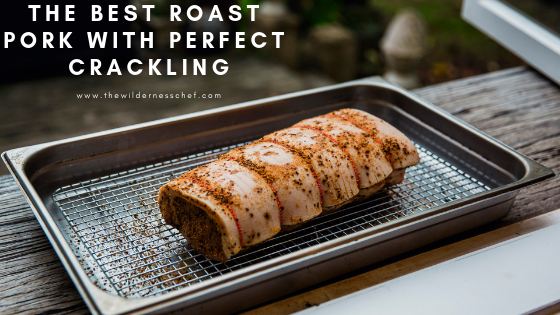The Best Roast Pork with Perfect Crackling!!!
‘For me, the sight, smell, heck even the idea of my sharp serrated knife trying to slice through the impenetrable layer of crackling that encases a soft, succulent, moist pork roast sends shivers down my spine & raises hairs on the back of my neck.’
Cooper Thomas - Owner /Executive Chef - The Wilderness Chef
Anyway, enough about my relationship with Roast Pork…let me tell you how to replicate it…
THE PERFECT PORK. The pork you use will determine your end result, full stop. The treatment of the produce we use (whether animal or plant) from day one will have a dramatic effect on the product you then put on the table. I always source Australian, free-range pork!
PREPARATION. Ensuring you achieve the perfect crackling starts now. The skin/rind of pork contains a lot of moisture & the key to perfecting your crackling is to remove as much moisture from the skin as possible! Curing your pork in a spiced salt/sugar mix will remove a large amount of the moisture even before the pork reaches the oven whilst also seasoning & imparting flavouring into your roast. Scoring the skin (by making 2-3mm deep incisions in the skin 1cm apart) allows the the flavours of the curing salt to penetrate the pork whilst making it much easier to slice once cooked.
CURE SALT RECIPE. In a 160 degree celsius oven toast the following spices for 6-8 minutes until they are aromatic. 3 cinnamon quills, 6 cardamon pods, 2 star anise, 1 tablespoon coriander seeds, 1 tablespoon fennel seeds. Once cooled, crush slightly using a mortar & pestle to release the aromas from within the spices. Combine the spices with 80g salt & 60g sugar. Season the pork liberally with the cure mix & leave it in the fridge for 4 hours to work its magic. Once the pork has cured, brush off the excess cure salt with a disposable wipe or hand towel.
Note: Place a cooling rack between the pork & the tray it is sitting on to ensure the liquid which is drawn out of the meat can run off freely.
SMOKING HOT. Pre-heat your even to 240 degrees celsius. Your oven MUST be extremely hot to ensure the next step of the perfect crackling goes to plan. As I said earlier, the trick is the remove the moisture from the skin whilst ensuring it remains inside the meat. The best way to cook a perfect steak is to seal it off in a pan to ensure the juices remain on the inside. Roasting pork needs to be exposed to the same concept but with a different method. By having your oven smokin’ hot for the first 30-40 minutes, you are sealing the meat, roasting the skin, dehydrating & ‘cooking out’ all of the moisture on the outside & creating a crispy crust to contain the juices that will be bursting from your pork! Cook your pork on the same cooling rack it was cured on, you’ll find out why later…
GET LOW. Now that your pork is sealed on the outside it’s time to turn your oven down to 160 degrees celsius & roast that pork ‘low & slow.’ As a rough guide, add 30 minutes for every kilogram of raw pork you started with. You’ll know your pork is cooked perfectly when the internal temperature reaches 62 degrees celsius & the juices run clear from within.
LET IT REST. As I’m sure you can imagine, once the pork comes out of the oven it is extremely stressed & therefore needs to rest… As a rough rule, you should rest all meat for half of the cooking time. If you have meat in the oven for 4 hours you most likely are not willing to wait a further 2 hours until you can slice it up. In this case 30-40 minutes is ample to allow the juices to run back into the grain of the meat. If you get impatient and feel like slightly the end piece off for a little taste, DON’T! Even one small slice into the meat and all of the juices, moisture & flavour will run straight out of the meat and end up all over the kitchen bench.
SLICE ACROSS THE GRAIN. This is a simple logic that can have catastrophic results if not done properly. The grain of meat is exactly the same as the grain of timber. It represents the direction that the muscle fibres run. Long story short, the shorter the muscle fibres are, the more tender the meat will be. If you slice with the grain, the muscle fibres will remain long, resulting in chewy meat. When meat is sliced across or against the grain, it shortens the muscle fibres to the thickness of the slice leaving you with gorgeous, melt in your mouth pork!
FEELING SAUCY. Still wondering why you cooked your pork on a cooling rack? All of the gorgeous, salty roasting juices are now going to become added flavour & moisture for your roast. Strain the juices & place them into the freezer for a few minutes. The fat will seperate to the top and solidify (become solid). Remove this fat, place it in a saucepan & bring to the heat. You want about 2 tablespoons in total, top the amount up with a butter to reach the desired measurement. Add 30g plain flour & cook for 3-4 minutes on low, stirring constantly until the flour taste is cooked out & the paste smells nutty. When fat & flour are cooked together it creates a roux. This is used to thicken the gravy. Add 100mL’s of quality red wine and reduce this down to cook out the alcohol. Follow this by adding approximately 600mL’s of roasting juices (top this up with chicken or beef stock if needed) and bring to the boil. Whisk while the stock comes to temperature to ensure the roux doesn’t form lumps within your gravy. Simmer this for 10 minutes until the gravy is thick & glossy.
Well that is it!! You now have the knowledge to execute a Roast Pork exactly the way Cooper Thomas, Owner/Executive Chef of The Wilderness Chef does.
Not in the mood to brave the kitchen?
Try our delicious pre-prepared banquet packages instead!






